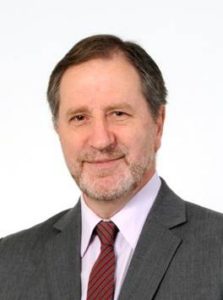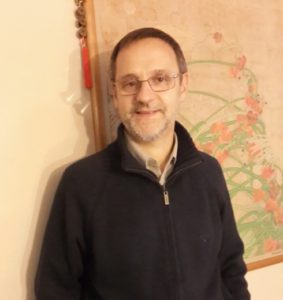 Esteban P. Busso is currently the Scientific Director of ONERA’s Materials and Structures Branch (approx. 250 permanent staff and 35 PhD students). ONERA is the largest public research establishment in France specialised in aerospace, aeronautics and defense with 1800 permanent staff. From 2005 till 2013 he was a Professor of Mechanics of Materials at the Ecole des Mines de Paris and Director of the Ecole’s Centre des Matériaux and, from 1994 till 2005, Professor at Imperial College’s Department of Mechanical Engineering in London, UK. Dr. Busso obtained his undergraduate degree from the University of Cordoba, Argentina, in Dec. 1980. In 1985, he joined the Massachusetts Institute of Technology (MIT) in Cambridge, USA, where he was awarded his MSc degree and, in 1990, his PhD degree in Mechanical Engineering. He has also worked in industry in the UK, Japan, South Africa and Argentina. His research involves micromechanics studies of deformation and fracture of materials and interfaces, with an emphasis on the development of multiscale and multiphysics concepts in mechanistic models to predict deformation and fracture processes.
Esteban P. Busso is currently the Scientific Director of ONERA’s Materials and Structures Branch (approx. 250 permanent staff and 35 PhD students). ONERA is the largest public research establishment in France specialised in aerospace, aeronautics and defense with 1800 permanent staff. From 2005 till 2013 he was a Professor of Mechanics of Materials at the Ecole des Mines de Paris and Director of the Ecole’s Centre des Matériaux and, from 1994 till 2005, Professor at Imperial College’s Department of Mechanical Engineering in London, UK. Dr. Busso obtained his undergraduate degree from the University of Cordoba, Argentina, in Dec. 1980. In 1985, he joined the Massachusetts Institute of Technology (MIT) in Cambridge, USA, where he was awarded his MSc degree and, in 1990, his PhD degree in Mechanical Engineering. He has also worked in industry in the UK, Japan, South Africa and Argentina. His research involves micromechanics studies of deformation and fracture of materials and interfaces, with an emphasis on the development of multiscale and multiphysics concepts in mechanistic models to predict deformation and fracture processes.
In August 2014, Dr. Busso was elected to the British Royal Academy of Engineering. He is a Fellow of the British Institute of Materials, Minerals and Mining and of the Societé Francaise des Matériaux, a Chartered Engineer in the UK and a member of the Royal Academy’s Aerospace Committee. He is currently the associate editor of Philosophical Magazine and until recently of the ASME Journal of Engineering Materials and Technology, and an Editorial Board member and guest editor of the Int. Journal of Plasticity, the Journal of Multiscale Modelling, the Journal of Mechanical Behavior of Materials, the journal of Materials at High Temperatures and the Journal of Materials Discovery. He has authored and edited 12 scientific books, and published over 135 articles in peer reviewed international journals (H-index of 29). He has also organised or co-organised 13 international conferences and more than 16 international symposia in the field of mechanics of materials. He has also taught materials and mechanics courses at the undergraduate and the graduate level for over 25 years. He is an advisor to industry worldwide, to the US Department of Energy, the European Commission, as well as the British, Dutch and French research councils, amongst others.
Appointments
From 11/13 ONERA – NATIONAL AEROSPACE RESEARCH CENTRE, Paris, FRANCE
10/05-10/13 ECOLE DES MINES DE PARIS, Centre des Matériaux, Paris, FRANCE
9/94-9/05 IMPERIAL COLLEGE, Dept. of Mechanical Eng., London, ENGLAND
2/92 – 8/94: WS ATKINS SCIENCE AND TECHNOLOGY, Epsom, ENGLAND
9/90 -11/91: HITACHI LTD., Mechanical Eng. Res. Lab., Tsukuba, JAPAN
8/85 – 7/90: MASSACHUSETTS INSTITUTE OF TECHNOLOGY, Dept. of Mechanical Eng. Cambridge, USA
3/85 – 7/85: ATLAS AIRCRAFT CORPORATION, Johannesburg, SOUTH AFRICA
7/83 – 2/85: ELECTRICITY SUPPLY COMMISSION, Test & Res. Dept., Johannesburg, SOUTH AFRICA
8/78 – 6/81: NATIONAL UNIVERSITY OF CORDOBA, Research Centre of Materials, Cordoba, ARGENTINA
Abstract of plenary conference:
On the Incorporation of Environmental effects in Multi-scale Modelling Approaches
This work deals with the study of environmental effects on the behaviour of Ni-based superalloys used in jet engines and on austenitic steels used in power plants. Such effects need to be considered as the mechanical behaviour of high temperature structural materials depends upon the variability of the microstructure, which is strongly conditioned by the severity of creep/oxidation interactions. Attention is particularly focused on the interaction between oxidation, time-dependent behaviour and microstructure and the local conditions responsible for the formation of surface and grain boundary micro-cracks. Methodologies based upon fundamental physical processes are presented for understanding and predicting oxide growth and the nucleation of associated damage.
First, the surface oxidation of Ni-base superalloys is described using a coupled diffusion-single crystal plasticity approach. When superalloys operate at high temperatures, the microstructure is not stable: the γ' precipitates coarsen rapidly and, in the vicinity of free surfaces, there is a depletion of the ’ precipitates due to surface oxidation. Both mechanisms lead to a local softening of the material which in turns reduces the local stresses. Here, the local material behaviour is made to depend explicitly on the characteristics of the ’-reinforcing phase which are, in turn, affected by the local concentrations of Ni, Al, and O2. The degradation of the local notch root region fields caused by the surface oxidation of a Ni-base superalloy notched compact tension (CT) specimen is discussed. Finite element analysis of the CT specimen revealed how environmental effects can severely reduce the time to crack initiation due to the oxidation-induced material softening.
The second part of this work deals with the growth of oxides along easy diffusion paths such as certain grain boundaries and localised deformation/slip bands intersecting free surfaces. Here, simultaneous surface and grain boundary oxidation phenomena in polycrystalline Fe-Cr-Ni austenitic steels are described through a coupled diffusion-crystal plasticity-phase field formulation. Oxidation is considered at the grain level where the effects of plasticity and grain boundaries on oxide growth are accounted for. Full field finite element simulations of a plastically deformed and oxidising bi-crystal are performed to describe the preferential oxide growth. The resulting preferential oxidation of the grain boundary is shown to depend on the wetting properties of the oxide interface with the grain boundary, the grain boundary energy and the relative grain boundary and bulk diffusivities.
 Fernando Augusto Actis, es Doctor en Ciencias de la Ingeniería, Universidad Nacional de Córdoba, Facultad de Ciencias Exactas, Físicas y Naturales. Orientación Materiales. Ingeniero Químico, Universidad Tecnológica Nacional, Facultad Regional Córdoba. Director de Calidad del Area Manager Sur, Ternium Siderar, Organización Techint (Argentina), con responsabilidad operativa en Argentina y sus países limítrofes. Miembro de Comité Científico del Roberto Rocca Education Program, para la asignación de becas doctorales destinadas a estudiantes destacados de Argentina, Brasil, Colombia, Malasia, México, Rumania y Venezuela, en universidades de primer nivel internacional. 2009 a la fecha. Miembro del Consejo Directivo. IPACE – Instituto Profesional Argentino para la Calidad y la Excelencia. Miembro del Consejo Académico del Posgrado en Siderurgia – Instituto Argentino de Siderurgia. Miembro del Consejo directivo del Centro de Materiales y del comité asesor de la carrera de Ing. Mecánica. ITBA – Instituto Tecnológico Buenos Aires. Anteriormente se desarrolló como Gerente de Ingeniería y Desarrollo de Productos con responsabilidad operativa en Ternium México, Ternium Internacional (Estados Unidos), Ternium Colombia, Ternium Centro América y Ternium Siderar. Coordinador de Producto Ternium Sidor, Organización Techint (Venezuela). Dpto. de Desarrollo de Producto, Coordinador de Aceros Revestidos Siderar, Organización Techint (Argentina). Asesor tecnológico Renacity Investment (Argentina). Dpto. de Desarrollo de Producto, Metalurgista Principal Siderar, Organización Techint (Argentina). Profesor de la Maestría en Siderurgia en la Universidad de Buenos Aires, Facultad de Ingeniería. Docente de la Carrera de Posgrado en Siderurgia de la Universidad Tecnológica Nacional, Facultad Regional San Nicolás. Profesor invitado para su Posgrado en Materiales Universidad Autónoma de Barcelona. Profesor de Fisicoquímica y Fisicoquímica Metalúrgica de la Universidad Tecnológica Nacional, Facultad Regional Córdoba. Docente de la Maestría en Ciencias de los Materiales Tecnológicos de la Universidad Nacional del Comahue, Facultad de Ingeniería. Responsable de la División Materiales del Centro de Investigación de Materiales y Metrología del Instituto Nacional de Tecnología Industrial (I.N.T.I.). Investigador categoría “B”, Régimen de incentivo a los docentes-investigadores de la Universidad Tecnológica Nacional, Facultad Regional Córdoba. Principales areas de trabajo: Procesamiento de Oxido de Uranio para elementos combustibles, Procesamiento de Ferritas de Mg-Zn, Ni-Zn y Mn-Zn para diversas aplicaciones, Imanes de Nd-Fe-B, Aceros eléctricos, Diseño de aplicaciones magnéticas por elementos finitos: motores eléctricos, Metrología magnética, Dewaxing de petróleos parafínicos.
Fernando Augusto Actis, es Doctor en Ciencias de la Ingeniería, Universidad Nacional de Córdoba, Facultad de Ciencias Exactas, Físicas y Naturales. Orientación Materiales. Ingeniero Químico, Universidad Tecnológica Nacional, Facultad Regional Córdoba. Director de Calidad del Area Manager Sur, Ternium Siderar, Organización Techint (Argentina), con responsabilidad operativa en Argentina y sus países limítrofes. Miembro de Comité Científico del Roberto Rocca Education Program, para la asignación de becas doctorales destinadas a estudiantes destacados de Argentina, Brasil, Colombia, Malasia, México, Rumania y Venezuela, en universidades de primer nivel internacional. 2009 a la fecha. Miembro del Consejo Directivo. IPACE – Instituto Profesional Argentino para la Calidad y la Excelencia. Miembro del Consejo Académico del Posgrado en Siderurgia – Instituto Argentino de Siderurgia. Miembro del Consejo directivo del Centro de Materiales y del comité asesor de la carrera de Ing. Mecánica. ITBA – Instituto Tecnológico Buenos Aires. Anteriormente se desarrolló como Gerente de Ingeniería y Desarrollo de Productos con responsabilidad operativa en Ternium México, Ternium Internacional (Estados Unidos), Ternium Colombia, Ternium Centro América y Ternium Siderar. Coordinador de Producto Ternium Sidor, Organización Techint (Venezuela). Dpto. de Desarrollo de Producto, Coordinador de Aceros Revestidos Siderar, Organización Techint (Argentina). Asesor tecnológico Renacity Investment (Argentina). Dpto. de Desarrollo de Producto, Metalurgista Principal Siderar, Organización Techint (Argentina). Profesor de la Maestría en Siderurgia en la Universidad de Buenos Aires, Facultad de Ingeniería. Docente de la Carrera de Posgrado en Siderurgia de la Universidad Tecnológica Nacional, Facultad Regional San Nicolás. Profesor invitado para su Posgrado en Materiales Universidad Autónoma de Barcelona. Profesor de Fisicoquímica y Fisicoquímica Metalúrgica de la Universidad Tecnológica Nacional, Facultad Regional Córdoba. Docente de la Maestría en Ciencias de los Materiales Tecnológicos de la Universidad Nacional del Comahue, Facultad de Ingeniería. Responsable de la División Materiales del Centro de Investigación de Materiales y Metrología del Instituto Nacional de Tecnología Industrial (I.N.T.I.). Investigador categoría “B”, Régimen de incentivo a los docentes-investigadores de la Universidad Tecnológica Nacional, Facultad Regional Córdoba. Principales areas de trabajo: Procesamiento de Oxido de Uranio para elementos combustibles, Procesamiento de Ferritas de Mg-Zn, Ni-Zn y Mn-Zn para diversas aplicaciones, Imanes de Nd-Fe-B, Aceros eléctricos, Diseño de aplicaciones magnéticas por elementos finitos: motores eléctricos, Metrología magnética, Dewaxing de petróleos parafínicos.
Resumen de la conferencia plenaria:
Tendencias en procesos y productos de aceros para la industria automotriz. Advanced High Strength Steels (AHSS) laminados en caliente y galvanizados
El acero es un material dinámico que evoluciona constantemente para dar respuestas a los requerimientos crecientes de la industria automotriz. Los aceros de muy alta resistencia constituyen el aporte de la industria siderúrgica a las exigencias de reducción de consumo de combustible y emisiones, mayor seguridad y confort. Las necesidades de fabricación de vehículos con menor peso, combinada con una mayor resistencia al choque, son los principales impulsores de la búsqueda de nuevos conceptos metalúrgicos tendientes a encontrar un compromiso entre resistencia máxima, ductilidad y soldabilidad, mediante la combinación de varias estructuras posibles, tales como ferrita poligonal y no poligonal, austenita retenida o estabilizada, bainita y martensita. Los aceros avanzados de alta resistencia (AHSS), y los aceros templables para aplicaciones automotrices, poseen una inserción creciente en las nuevas plataformas de automóviles y naturalemente han generado también un impacto notable en la configuración de las instalaciones industriales destinadas a su procesamiento. Este trabajo brinda una visión general de los últimos desarrollos en el campo de los AHSS laminados en calientes y galvanizados por inmersión y presenta las tendencias industriales que empiezan a consolidarse.


